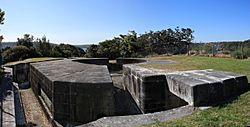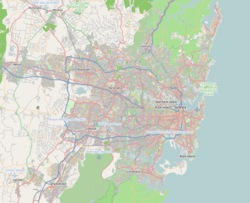Steel Point Battery facts for kids
The Steele Point Battery is a small fort. It sits on the shores of Sydney Harbour in the eastern Sydney suburb of Vaucluse, New South Wales, Australia.
Contents
Why Was the Fort Built?
People started talking about needing forts to protect Sydney Harbour as early as 1857. At that time, there were worries about a possible attack from Russia. Also, British soldiers were leaving Australia, so the country needed to protect itself more.
Building the Fort
Construction of the fort began in 1871 and finished in 1874. A barracks (living quarters for soldiers) was added in 1880. A famous architect named James Barnet designed this fort. He also designed many other forts around Sydney Harbour during this time.
Early Guns at Steele Point
In 1872, three large 80-pounder guns were installed. These were called "rifled muzzle-loading guns." Later, the fort was rearmed with three 5-inch breech-loading guns.
Confusion with Another Fort
There was another fort also called "Shark Point Battery" near Clovelly. That fort had a very large 9.2-inch gun. This big gun was designed to "disappear" into a pit after firing to protect it. The Steele Point Battery (in Vaucluse) and the Clovelly battery were different forts.
How the Fort Worked
The Steele Point Battery was part of a group of forts protecting Sydney Harbour. Other forts built around the same time (1871) included the Middle Head Fortifications, Georges Head Battery, and Bradleys Head Fortification Complex. These forts worked together to defend the city from attacks by sea.
Fort Design
The fort had three gun emplacements, which are special pits where the guns were placed. These pits were made of sandstone. Passages connected these pits to underground rooms. These rooms included:
- A gunpowder magazine (where gunpowder was stored).
- A shell and artillery store (for ammunition).
- Two shell and lamp recesses (small storage areas).
The fort also had its own living quarters for the soldiers. For security, it was surrounded by a picket fence and a barbed wire fence. There was even a jetty (a small pier) with roads leading to the fort.
Steele Point Today
Today, you can still see the three gun emplacements. Some of the passageways, tunnels, and the magazine store are partly buried. The stone entrance to one of the tunnels was damaged, and debris filled it.
The lower parts of the fort and connecting passages are in good condition. One gun emplacement is still visible above ground.
Who Owns It Now?
In 1980, the land became part of the state of New South Wales. Now, the New South Wales National Parks and Wildlife manages it. A small part of the land is used by the Royal Australian Navy as a degaussing station. This station helps ships become less magnetic. The larger area around the fort is part of Nielsen Park and is a heritage site.
The name of the point was officially changed from "Steel Point" to "Steele Point" in 1993.



